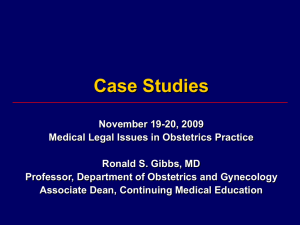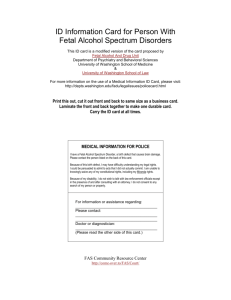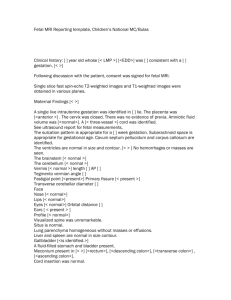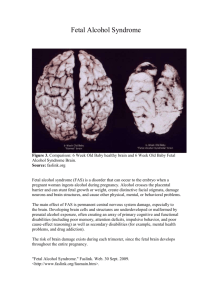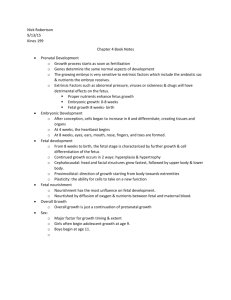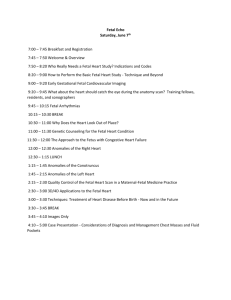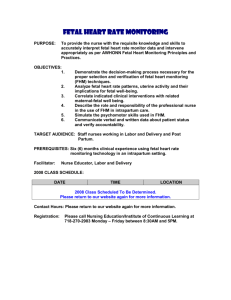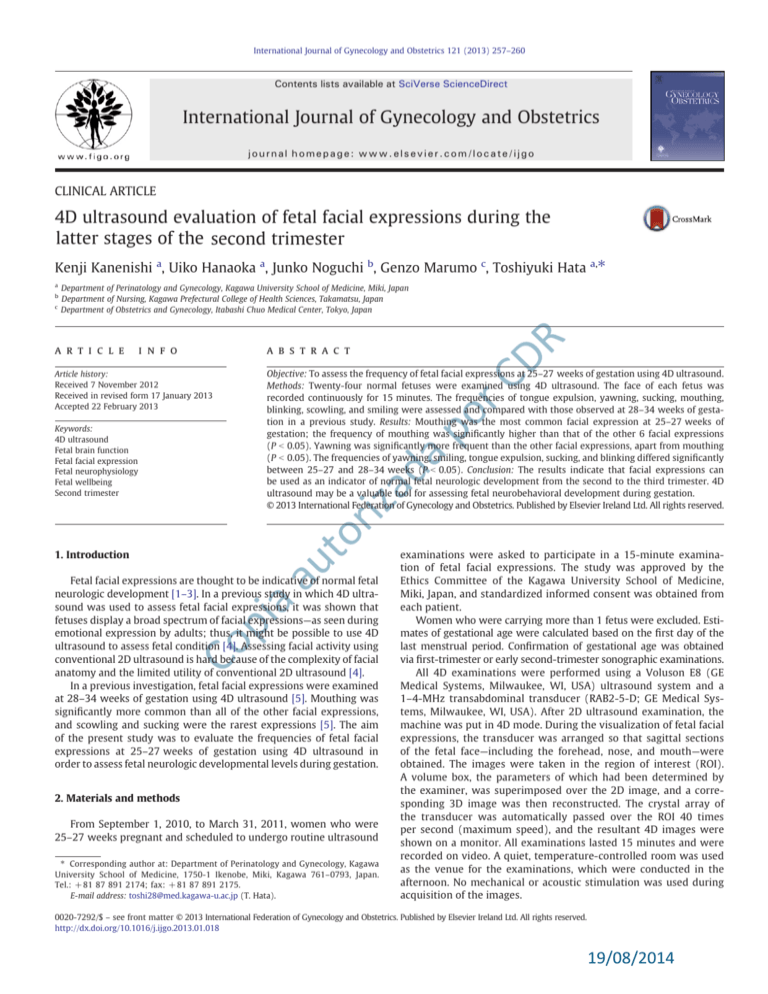
International Journal of Gynecology and Obstetrics 121 (2013) 257–260
Contents lists available at SciVerse ScienceDirect
International Journal of Gynecology and Obstetrics
journal homepage: www.elsevier.com/locate/ijgo
CLINICAL ARTICLE
4D ultrasound evaluation of fetal facial expressions during the
latter stages of the second trimester
Kenji Kanenishi a, Uiko Hanaoka a, Junko Noguchi b, Genzo Marumo c, Toshiyuki Hata a,⁎
c
Department of Perinatology and Gynecology, Kagawa University School of Medicine, Miki, Japan
Department of Nursing, Kagawa Prefectural College of Health Sciences, Takamatsu, Japan
Department of Obstetrics and Gynecology, Itabashi Chuo Medical Center, Tokyo, Japan
a r t i c l e
i n f o
a b s t r a c t
Objective: To assess the frequency of fetal facial expressions at 25–27 weeks of gestation using 4D ultrasound.
Methods: Twenty-four normal fetuses were examined using 4D ultrasound. The face of each fetus was
recorded continuously for 15 minutes. The frequencies of tongue expulsion, yawning, sucking, mouthing,
blinking, scowling, and smiling were assessed and compared with those observed at 28–34 weeks of gestation in a previous study. Results: Mouthing was the most common facial expression at 25–27 weeks of
gestation; the frequency of mouthing was significantly higher than that of the other 6 facial expressions
(P b 0.05). Yawning was significantly more frequent than the other facial expressions, apart from mouthing
(P b 0.05). The frequencies of yawning, smiling, tongue expulsion, sucking, and blinking differed significantly
between 25–27 and 28–34 weeks (P b 0.05). Conclusion: The results indicate that facial expressions can
be used as an indicator of normal fetal neurologic development from the second to the third trimester. 4D
ultrasound may be a valuable tool for assessing fetal neurobehavioral development during gestation.
© 2013 International Federation of Gynecology and Obstetrics. Published by Elsevier Ireland Ltd. All rights reserved.
po
Article history:
Received 7 November 2012
Received in revised form 17 January 2013
Accepted 22 February 2013
DR
b
rC
a
ut
or
iza
da
Keywords:
4D ultrasound
Fetal brain function
Fetal facial expression
Fetal neurophysiology
Fetal wellbeing
Second trimester
1. Introduction
Co
pi
aa
Fetal facial expressions are thought to be indicative of normal fetal
neurologic development [1–3]. In a previous study in which 4D ultrasound was used to assess fetal facial expressions, it was shown that
fetuses display a broad spectrum of facial expressions—as seen during
emotional expression by adults; thus, it might be possible to use 4D
ultrasound to assess fetal condition [4]. Assessing facial activity using
conventional 2D ultrasound is hard because of the complexity of facial
anatomy and the limited utility of conventional 2D ultrasound [4].
In a previous investigation, fetal facial expressions were examined
at 28–34 weeks of gestation using 4D ultrasound [5]. Mouthing was
significantly more common than all of the other facial expressions,
and scowling and sucking were the rarest expressions [5]. The aim
of the present study was to evaluate the frequencies of fetal facial
expressions at 25–27 weeks of gestation using 4D ultrasound in
order to assess fetal neurologic developmental levels during gestation.
2. Materials and methods
From September 1, 2010, to March 31, 2011, women who were
25–27 weeks pregnant and scheduled to undergo routine ultrasound
⁎ Corresponding author at: Department of Perinatology and Gynecology, Kagawa
University School of Medicine, 1750-1 Ikenobe, Miki, Kagawa 761–0793, Japan.
Tel.: + 81 87 891 2174; fax: + 81 87 891 2175.
E-mail address: toshi28@med.kagawa-u.ac.jp (T. Hata).
examinations were asked to participate in a 15-minute examination of fetal facial expressions. The study was approved by the
Ethics Committee of the Kagawa University School of Medicine,
Miki, Japan, and standardized informed consent was obtained from
each patient.
Women who were carrying more than 1 fetus were excluded. Estimates of gestational age were calculated based on the first day of the
last menstrual period. Confirmation of gestational age was obtained
via first-trimester or early second-trimester sonographic examinations.
All 4D examinations were performed using a Voluson E8 (GE
Medical Systems, Milwaukee, WI, USA) ultrasound system and a
1–4-MHz transabdominal transducer (RAB2-5-D; GE Medical Systems, Milwaukee, WI, USA). After 2D ultrasound examination, the
machine was put in 4D mode. During the visualization of fetal facial
expressions, the transducer was arranged so that sagittal sections
of the fetal face—including the forehead, nose, and mouth—were
obtained. The images were taken in the region of interest (ROI).
A volume box, the parameters of which had been determined by
the examiner, was superimposed over the 2D image, and a corresponding 3D image was then reconstructed. The crystal array of
the transducer was automatically passed over the ROI 40 times
per second (maximum speed), and the resultant 4D images were
shown on a monitor. All examinations lasted 15 minutes and were
recorded on video. A quiet, temperature-controlled room was used
as the venue for the examinations, which were conducted in the
afternoon. No mechanical or acoustic stimulation was used during
acquisition of the images.
0020-7292/$ – see front matter © 2013 International Federation of Gynecology and Obstetrics. Published by Elsevier Ireland Ltd. All rights reserved.
http://dx.doi.org/10.1016/j.ijgo.2013.01.018
19/08/2014
258
K. Kanenishi et al. / International Journal of Gynecology and Obstetrics 121 (2013) 257–260
As described previously [5], the examiner assessed 7 types of
facial expression when viewing the video recordings: blinking
(Supplementary Material S1 [fetal blinking at 27 weeks of gestation]); mouthing (Supplementary Material S2 [fetal mouthing at
26 weeks of gestation]); yawning (Supplementary Material S3 [fetal
yawning at 27 weeks of gestation]); smiling (Supplementary Material
S4 [fetal smiling at 27 weeks of gestation]); tongue expulsion
(Supplementary Material S5 [fetal tongue expulsion at 27 weeks of
gestation]); scowling (Supplementary Material S6 [fetal scowling at
26 weeks of gestation]); and sucking (Supplementary Material S7
[fetal sucking at 27 weeks of gestation]). Each facial expression has
been described in detail previously [5]. The frequency of each fetal facial
expression was assessed by an author (K.K.) who has extensive experience in the field; the results are shown as median and range values.
The frequencies of the facial expressions at 25–27 weeks of gestation
were compared using the Kruskal–Wallis 1-way analysis of variance
by ranks test. The frequencies of each facial expression at 25–27 and
28–34 weeks of gestation were compared using the Mann–Whitney
test. The data for 28–34 weeks were obtained from a previous study
[5]. All calculations were performed using SPSS version 16 (IBM,
Armonk, NY, USA). P b 0.05 was considered to be statistically significant.
was significantly more frequent than the other 6 facial expressions
(P b 0.05) (Fig. 1). Yawning was significantly more frequent than
the other facial expressions, apart from mouthing (P b 0.05) (Fig. 1),
and smiling was significantly more frequent than blinking (P b 0.05).
The frequencies of yawning, smiling, tongue expulsion, sucking,
and blinking at 25–27 weeks were significantly different from
those at 28–34 weeks (P b 0.05) (Fig. 2). However, the frequencies
of scowling and mouthing did not differ between 25–27 and
28–34 weeks (Fig. 2).
4. Discussion
Co
pi
aa
ut
DR
or
iza
da
po
rC
3. Results
Twenty-four pregnant women agreed to participate in the study,
none of whom smoked or had any complicating diseases. Median gestational age at examination was 27 weeks (range, 25–27 + 6 weeks).
All infants were born at 37 weeks or later. The birth weights of all
but 1 of the infants (which was small for gestational age but healthy)
were within the reference range (between the 10th and the 90th
percentiles) on the standard curve for Japanese neonates [6]. No
congenital malformations, genetic disorders, or abnormal neurologic
development was observed in any of the neonates.
As described previously [5], it was difficult to observe fetal faces
when they were obscured by the umbilical cord or fetal extremities,
or were facing the uterine or placental wall. Thus, placental and
uterine walls were excluded from the ROI when possible. A suitable
facial view was achieved in every case by moving the probe or asking
the mother to alter her position.
The median frequencies of mouthing, yawning, smiling, tongue
expulsion, scowling, sucking, and blinking at 25–27 weeks of gestation were 6 (range, 1–10), 1 (0–4), 0 (0–2), 0 (0–3), 0 (0–1),
0 (0–1), and 0 (0–2), respectively (Fig. 1). At 25–27 weeks, mouthing
Several studies have involved 4D ultrasound examinations of
fetal facial expressions late in the second trimester and early in
the third trimester [5,7–9]. Kurjak et al. [8] detected variations in facial expression frequency in the second and third trimesters. The
frequencies of all of the examined facial expressions peaked during
the latter stages of the second trimester, except for that of isolated
eye blinking, which increased at the start of week 24. During the
early stages of the third trimester, decreased or unchanged fetal
facial expression frequencies were observed [8]. In the study
by Yigiter and Kavak [9], the frequencies of yawning, sucking,
swallowing, smiling, mouthing, and tongue expulsion were highest
at 24–32 weeks, whereas grimacing peaked at 28–36 weeks and
eye blinking peaked after week 32. Kurjak et al. [7] also reported
that concurrent eyelid and mouthing movements were the predominant expressions at 30–33 weeks. In the present and previous investigations [5], the most frequent facial expression was mouthing
at 25–27 and 28–34 weeks of gestation; the frequency was significantly higher than that of the other facial expressions. The frequency of yawning was significantly higher than that of the other
facial expressions, except for mouthing, at 25–27 weeks. Moreover,
the frequencies of yawning, smiling, tongue expulsion, sucking, and
blinking at 28–34 weeks were significantly higher than those observed at 25–27 weeks. The reasons for the discrepancies between
these findings and those of other groups regarding the incidences
of fetal expressions during the latter stages of the second trimester
and the early stages of the third trimester are unknown. However,
4D ultrasound assessments of fetal facial expressions rely on the subjective judgment of the examiner, so inter-observer variability might
be an issue with 4D ultrasound assessments of fetal facial expressions. Further studies are needed to determine appropriate levels
of inter-observer agreement for such investigations. Moreover, an
Fig. 1. Comparison of the frequencies of fetal facial expressions at 25–27 weeks of gestation.
19/08/2014
259
DR
K. Kanenishi et al. / International Journal of Gynecology and Obstetrics 121 (2013) 257–260
Acknowledgments
The work reported in the present paper was supported by a
Grant-in-Aid for Scientific Research on Innovative Areas “Constructive
Developmental Science” (No. 24119004) from The Ministry of Education, Culture, Sports, Science, and Technology, Japan.
Co
pi
aa
ut
or
iza
da
objective method of analyzing facial expressions using automated
objective recognition systems should be developed. The frame
rate of the machine employed in the present study might also have
affected the results. In previous studies, the frame rate was 0.5
frames per second [7–9], except for 1 study in which it was 4–6
frames per second [5]; by contrast, the maximum frame rate in the
present study was 40 frames per second. Other possible reasons for
the discrepancies are the small study populations examined in the
present study and those of previous researchers, and variations in
examination time among the studies. Examinations in the present
study lasted 15 minutes, as was the case in other studies [5,7],
whereas they took 30 minutes in 2 other investigations [8,9]. The
problems associated with a short examination period have been
described by Kurjak et al. [10]. More studies involving larger study
populations and an extended observation period are required to
assess precisely the frequencies of fetal facial expressions during
the second and third trimesters of pregnancy.
As stated by Kurjak et al. [11], the ability to evaluate fetal behavior might increase knowledge regarding fetal central nervous
system development. In addition, it might be possible in future to
use the functional characteristics of a fetus, as determined by 4D
ultrasound, to predict potential developmental problems [11]. 4D
ultrasound examinations of fetal facial expressions might provide
useful information for diagnosing and understanding fetal brain
disorders in utero, and they could even result in the elucidation
of novel fetal behavioral functions [4]. Kurjak et al. [12] developed
a points-based system (the Kurjak Antenatal Neurological Test)
for evaluating the neurologic status of fetuses via 4D ultrasound,
and several studies have assessed the utility of 4D ultrasound
for distinguishing between normal and borderline or abnormal
fetal behavior during both normal and high-risk pregnancies
[13–17]. The present study offers new insights into the neurologic
development of the fetus and might help to determine whether
frequencies of fetal facial expressions at a specific gestational age
are indicative of specific neurologic disorders. Further studies are
necessary to clarify the potential of 4D ultrasound for evaluating
fetal neurobehavior.
po
rC
Fig. 2. Comparison of the frequency of each fetal facial expression between 25–27 and 28–34 weeks of gestation. Data regarding frequencies of fetal facial expressions at
28–34 weeks were obtained from a previous study [5].
Supplementary data to this article can be found online at http://
dx.doi.org/10.1016/j.ijgo.2013.01.018.
Conflict of interest
The authors have no conflicts of interest.
References
[1] Prechtl HF. Qualitative changes of spontaneous movements in fetus and preterm
infant are a marker of neurological dysfunction. Early Hum Dev 1990;23(3):
151–8.
[2] Prechtl HF. State of the art of a new functional assessment of the young nervous
system. An early predictor of cerebral palsy. Early Hum Dev 1997;50(1):1–11.
[3] Prechtl HF, Einspieler C. Is neurological assessment of the fetus possible? Eur J
Obstet Gynecol Reprod Biol 1997;75(1):81–4.
[4] Hata T, Dai SY, Marumo G. Ultrasound for evaluation of fetal neurobehavioural
development: from 2-D to 4-D ultrasound. Infant Child Dev 2010;19(1):99–118.
[5] Yan F, Dai SY, Akther N, Kuno A, Yanagihara T, Hata T. Four-dimensional sonographic assessment of fetal facial expression early in the third trimester. Int J
Gynecol Obstet 2006;94(2):108–13.
[6] Ogawa Y, Iwamura T, Kuriya N, Nishida H, Takeuchi H, Takada M, et al. Birth size
standards by gestational age for Japanese neonates. Acta Neonatal Jpn 1998;34(3):
624–32.
[7] Kurjak A, Azumendi G, Vecek N, Kupesic S, Solak M, Varga D, et al. Fetal hand movements and facial expression in normal pregnancy studied by four-dimensional
sonography. J Perinat Med 2003;31(6):496–508.
[8] Kurjak A, Andonotopo W, Hafner T, Salihagic Kadic A, Stanojevic M, Azumendi G,
et al. Normal standards for fetal neurobehavioral developments–longitudinal
quantification by four-dimensional sonography. J Perinat Med 2006;34(1):56–65.
[9] Yigiter AB, Kavak ZN. Normal standards of fetal behavior assessed by fourdimensional sonography. J Matern Fetal Neonatal Med 2006;19(11):707–21.
[10] Kurjak A, Stanojevic M, Andonotopo W, Scazzocchio-Duenas E, Azumendi G,
Carrera JM. Fetal behavior assessed in all three trimesters of normal pregnancy
by four-dimensional ultrasonography. Croat Med J 2005;46(5):772–80.
[11] Kurjak A, Stanojević M, Predojević M, Laušin I, Salihagić-Kadić A. Neurobehavior
in fetal life. Semin Fetal Neonatal Med 2012;17(6):319–23.
[12] Kurjak A, Miskovic B, Stanojevic M, Amiel-Tison C, Ahmed B, Azumendi G, et al. New
scoring system for fetal neurobehavior assessed by three- and four-dimensional
sonography. J Perinat Med 2008;36(1):73–81.
[13] Kurjak A, Abo-Yaqoub S, Stanojevic M, Yigiter AB, Vasilj O, Lebit D, et al. The
potential of 4D sonography in the assessment of fetal neurobehavior–multicentric
study in high-risk pregnancies. J Perinat Med 2010;38(1):77–82.
19/08/2014
260
K. Kanenishi et al. / International Journal of Gynecology and Obstetrics 121 (2013) 257–260
[14] Miskovic B, Vasilj O, Stanojevic M, Ivanković D, Kerner M, Tikvica A. The comparison of fetal behavior in high risk and normal pregnancies assessed by four
dimensional ultrasound. J Matern Fetal Neonatal Med 2010;23(12):1461–7.
[15] Talic A, Kurjak A, Ahmed B, Stanojevic M, Predojevic M, Kadic AS, et al. The potential of 4D sonography in the assessment of fetal behavior in high-risk pregnancies.
J Matern Fetal Neonatal Med 2011;24(7):948–54.
Co
pi
aa
ut
or
iza
da
po
rC
DR
[16] Stanojevic M, Talic A, Miskovic B, Vasilj O, Shaddad AN, Ahmed B, et al. An attempt
to standerdize Kurjak’s Antenatal Neurodevelopmental Test: Osaka consensus
statement. Donald Sch J Ultrasound Obstet Gynecol 2011;5(4):317–29.
[17] Talic A, Kurjak A, Stanojevic M, Honemeyer U, Badreldeen A, DiRenzo GC. The
assessment of fetal brain function in fetuses with ventrikulomegaly: the role of
the KANET test. J Matern Fetal Neonatal Med 2012;25(8):1267–72.
19/08/2014

